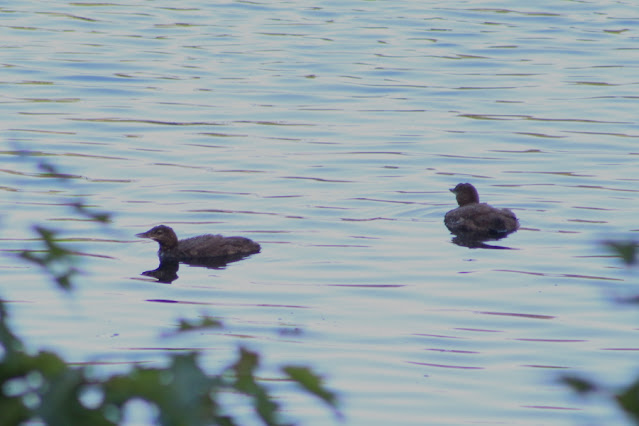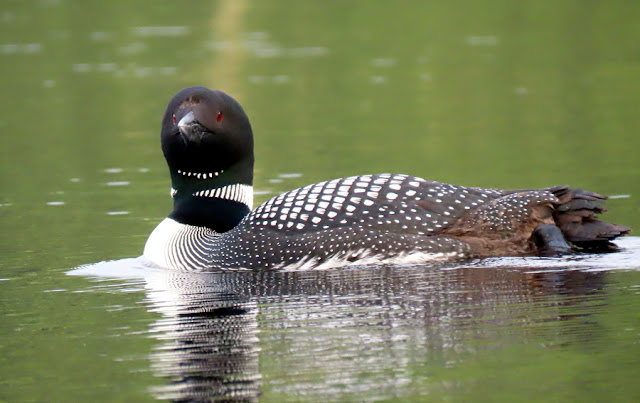Often in the summer a dock spider takes up residence in our boat, but this summer a different arachnid took over that real estate.
 |
| A cross orb-weaver spider (Araneus diadematus) secures her prey. |
Females of this species make the web, and I couldn't tell what kind of insect she caught because she had already killed it and had it all wrapped up in silk - but it's large, maybe a deerfly or a bee.
Spiders have the ability to create different kinds of silk for different uses, such as a strong silk for the frame of their web (which they walk on) and a sticky silk for trapping prey. It's not the first time we've had an orb-weaver on the boat and it seems that only one type of spider will live there at time. There's even been a third kind of spider some years, a long-jawed orb-weaver, including earlier this summer, but that one has disappeared now that the orb-weaver has shown up. There are several webs on the boat and the dock, and I feel a little guilty disturbing them when I use the boat, but she doesn't seem to mind - there's always a new one there the next morning.
 |
| Two webs span from the dock to the boat, one on the bow, one on the stern. |
I'm assuming the same spider owns all the webs because I only see one spider, with the other webs unoccupied. Yesterday morning the homeowner appeared to be sleeping in late, right in the center of one of the webs.
 |
| Or maybe she's subduing another dinner guest. |
Sometimes a spider will get lucky and trap a real feast such as a dragonfly, but not this one:
 |
| Yellow-sided Skimmer (Libellula flavida) |
This pretty yellow-sided skimmer was resting on a blueberry bush right next to one of the spider's webs. The dark wingtips and the slight amber coloring on the leading edges of the wing add to the beauty of this species of odonata, especially in the soft evening sun. Early in summer males and females have the same coloring, but as the summer progresses, males develop a powdery blue coloring called pruinose, a fine dusting on their abdomen. [Ref: Yellow-sided Skimmer New York National Heritage Program] It's not known why this happens, though it may be to reflect sunlight to reduce heating, a useful feature this past week. I've seen these blue dragonflies but didn't know what they were. I'll watch for them this summer.
I saw another dragonfly with almost the inverse coloring on Linda's hibiscus plant; I haven't been able to identify this one yet.
Dragonflies are ancient animals. In the Permian period (275 million years ago) the largest species had a two and half foot wing span which made it the largest insect known to have existed on Earth [Ref: Largest Extinct Insect, University of Nebraska]. Like many animals they have shrunk dramatically in size over time, but some dragonflies are almost as large as some birds. We sometimes see a hummingbird drinking nectar from the bright red hibiscus blossoms but rarely get a picture. It was Debby Crowely that took this fabulous photograph of a ruby-throated hummingbird.
 |
| Ruby-throated hummingbird. Photo by Debby Crowley |
In case you're wondering, Debby used a 1/1000 of a second shutter speed to capture that image.
The loon update has LuLu and Checkers growing by leaps and bounds.
 |
| LuLu |
 |
| Checkers on the left, LuLu on the right. |
Mom spends lots of time with them, giving them their daily lessons.
 |
| Morning Lessons. Note the band on mom's left leg. |
These pictures from Debby explain any mystery of how these chicks can grow so quickly.
 |
| "Thanks mom." Photo by Debby Crowley. |
 |
| "I can do it." Photo by Debby Crowley. |
Yet they still have a ways to go before they grow into those huge webbed feet.
 |
| LuLu showed off her bright white chest while she waved at me. |
With August almost here, the predominant colors of the flowers are changing; this week, yellow was the word.
 |
| Black-eyed Susan |
 |
| Woodland Sunflower |
Bees like yellow.
Soon the goldenrod will bloom, adding acres of gold to the fields around the Lakes Region. It will be a reminder that summer is progressing, and that we should enjoy these long summer days, no matter how hot and humid.
The coming week looks to be better.



























.jpg)

















